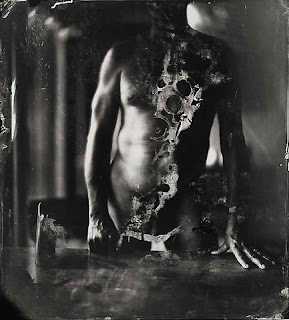 |
| Sally Mann "Emmett, Jessie, and Virginia" 1989 |
Sally Mann fans who missed her show at the Photographer’s Gallery in London will want to make the journey to Karsten Greve Gallery in the Marais before December 10. What Karsten Greve are billing as a retrospetive is more accurately a summary of four of Mann’s different artistic periods. On exhibition are samplings from the series: Deep South 1996-1998, Battlefields 2000-2002, Faces 2004, and Proud Flesh 2004-2009. Though it is not as comprehensive as Karsten Greve claims, the exhibition is significant for Mann and for Paris. I have never seen Karsten Greve filled with so many people; indeed it felt like I was at the Grand Palais seeing Monet.
 |
| Sally Mann, Candy Cigarette, 1989 |
Mann is probably best known for the troubling photographs of her three young children. Mann’s girls, Jessie in particular, pose provocatively and precociously for the camera such that their young adolescent bodies take on the seduction and wisdom of promiscuous, self-assured, adult women. The handful of these photographs on display at Karsten Greve are, as always, provocative and confrontational, and yet somehow tragic. What is the world we live in where young girls already know the postures and gestures of sexual seduction well before they have reached puberty? And the fact that we know her mother is behind the camera makes the famous image of Jessie in “Candy Cigarette”, 1989, heartwrenching.
 |
| Sally Mann, The Quality of the Affection, 2006 |
However, the most extraordinary photographs on display, and those given pride of place at Karsten Greve are the most recent, those of her husband Larry, taken from the series Proud Flesh, published in 2009. The images are taken over a six year period as something like documents of the effects of muscular dystrophy on Larry's body. If the viewer did not know Larry has muscular dystrophy, it would not matter. Indeed, to see Larry’s body for the first time, unknowingly, would perhaps enhance the beauty of the images, the tenderness of their vision. We see fragments of his body, a thigh, a forearm, his back. There are no faces, no identifying features, and there is nothing beautiful about this body, these limbs suspended in light. And yet, Mann’s camera, her processing techniques, her eye, offer a vision of a body so loved, so powerful, appearing here with an intimacy that I would have thought impossible to translate into a photograph.
 |
| Sally Mann, Somnabulist, 2009 |
There is also something about the images that makes them like x-ray photographs, giving them a scientificity, a matter-of-factness. Look, it’s a leg, skin and bones, held to the light, become transparent.
And yet, they are much more, because of the way the limb is placed, the gentle caress of the light across the veins and hairs on a body whose muscles are wasting, each one in its place, with its own individual meaning. That intensity and intimacy is heartbreaking, because of the love that enables each hair to appear in the first place. The love, sadness, anger across the passing of time is also in the vulnerability of a man, exposed. For a man — not a woman — to be photographed naked, his body in a state of deterioration, he has to trust the person taking that photograph. His vulnerability is laid bare by Mann, especially, but not only, when his genitals are the focal point of the image, sagging.
 |
| Sally Mann, Deep South, #1, 1998 |
Lastly, a brief word about the landscapes in the Deep South series also on display at Karsten Greve. Like siblings to Proud Flesh, these images show the wreckage of a Holocaust of a different kind, on a landscape not so far removed from that of the human body with a wasting disease: the American Civil War. In Mann's photographs, this is a world where trees cry, where they are wounded, cut, stabbed, where nothing has survived the violence and the anger. These beautiful trees have been left longing, knowingly, as if yearning for a time before they were ravaged by the inhumanity of war. Again these images capture memory and time passing on the surface of the tree, the surface of the image. And like those in Proud Flesh, the light and the photographic process lovingly caress their wounds and the incisions of time and age. And yet, like Larry's body, they are not stagnant or dead, even if they might be on the way to death. I would not be surprised to see a monster appear out of the mist – there is something in the unpredictability of Mann's photographic method that makes these images like a volcano threatening to erupt. Even though Mann's work is always recognized for its discourse on death and destruction, as we see from these photographs, it is just as much about the unknown, the possibility that is always on the horizon of a photographed world made uncertain by a turmoil not yet begun.


No comments:
Post a Comment